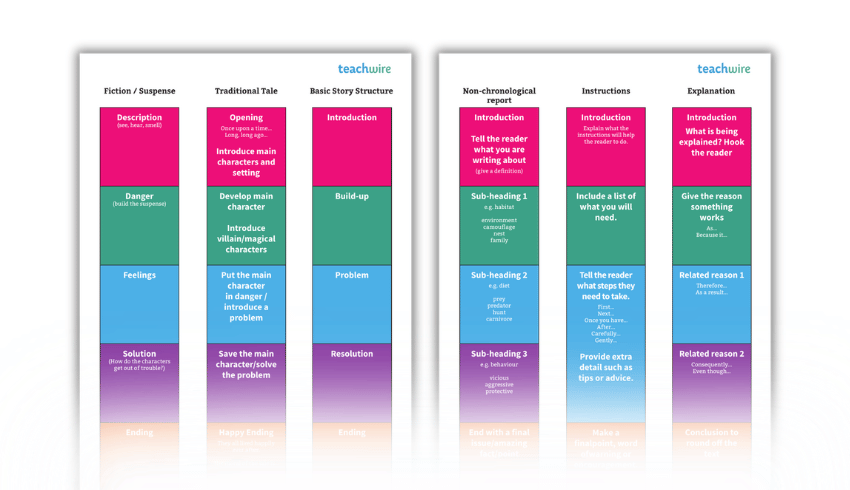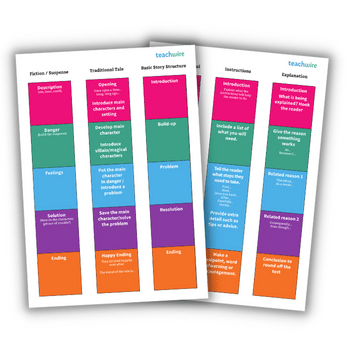PDF lesson plan and printable structure strips for writing texts of a variety of genres
KS2
Years 3-6
Try structure strips in your next English class with this advice from Rebecca Jakes and our free downloadable structure strips templates…
I love the promise of a fresh English unit – the hook, the newly written model text, the opportunity to enjoy an unexplored genre. So why is it that so many children struggle with the final outcome?
We’ve all been there. You’ve planned a clear learning journey, explored the text with the class and modelled how children can write their own versions. But when you come to mark the work, despite all this build up, you find:
- repetition
- a lack of coherence
- muddled, undernourished paragraphs
The children have ignored their plans and rushed, giving little thought to the purpose of each section; structure has gone out of the window.
It’s hardly surprising. Writing is hard enough to draft when you are an adult, so why do we expect children to compose their work so quickly and easily?
I took to the internet in search of the answer. It was at this point that I discovered ‘structure strips’. These are a teaching strategy that took the EduTwitter world by storm in 2018.
The idea was first created and shared on Twitter by teacher Stephen Lockyer before being championed by Caroline Spalding, an assistant head at an all-through school.
What are structure strips?

Put simply, a structure strip is a tool that supports pupils with structuring a text. It prompts them to consider what they should include in each paragraph.
Though initially used to support children in KS3, the strips were picked up by primary schools across the country.
Structure strips are designed to be stuck in the margin of an exercise book. Every strip is divided into sections that act as a guide for the content, order and relative size of each paragraph. They can be colour coded to make each section stand out, or left plain for simplicity.
Let’s take teaching children to write a basic short story as an example. A common approach is to ask pupils to use a simple format: build up, problem, resolution, ending.
Placing a structure strip with these headings in the margin of a child’s book provides them with a clear reminder of which part of their story they are developing as they write.
Download our example structure strips template from the top of this page.
“Every strip is divided into sections that act as a guide for the content, order and relative size of each paragraph”
Supporting different abilities
One of the best things about structure strips is that they can be easily adapted according to the level of support you want to give.
For example, in the apprentice phase of writing – where pupils are still learning how to a write a story – you might include quite specific prompts. This might be key vocabulary or suggestions for different conjunctions or sentence openers.
But by the end of a unit when children are producing an independent piece, more generic prompts such as ‘build the suspense’ or ‘show, not tell’ can be added to help children develop their writing.
For pupils who need extra support, the sections of a structure strip could contain specific words that you want them to use. You can even add picture prompts if necessary.
The strips are particularly useful for pupils who are aiming to achieve greater depth in writing; this works especially well for Y6 pupils.
For example, you could edit the strip to remind them to vary the authorial voice or punctuation. You could even add an example of what this would look like.
“What about moderation?” I hear you cry. Well, writing at greater depth requires practice. Structure strips give children the guidance and support they need whilst learning to do this.
Eventually, these new skills will transfer to work that’s produced independently.
Structure strips are well suited to teaching non-fiction where there is less room for manoeuvre in terms of layout and ordering of paragraphs.
Take a notoriously tricky genre such as an explanation text, for example. Here you can add questions to prompt children (e.g. ‘What is the item used for?’ or ‘Why does this occur?’). Including technical vocabulary also works as an effective reminder.
What can go wrong when using structure strips?
As with any tool to support writing, structure strips have one or two limitations. They won’t, for example, work for every genre. And you need to carefully model how they should be used (and I speak from experience).
Take care to ensure children understand they are still writing paragraphs. I had one child who wrote every sentence on a separate line, simply because the introduction of a new strategy completely threw him.
Size of handwriting can also cause problems when using the strips. Pupils who struggle with letter formation may find they can only fit one or two sentences in the space provided.
There are a couple of ways around this. One is to provide strips with larger sections. And the other is to cut the strip up. Then you can stick in each section once children have finished the previous paragraph.
“You need to carefully model how they should be used”
For pupils who are very skilled and creative, some may argue this strategy will hold them back, interrupting the flow of their writing.
If used carefully, however, they can add an extra level of challenge for more able writers. Asking pupils to create a paragraph in a limited space that builds suspense and imagery forces them to really think about each word and sentence they are using.
Tying in assessment
Not only are structure strips a great tool for supporting writing, they can also work as a guide for self and peer-assessment. This is because the sections provide pupils with ready-made criteria against which to mark.
There’s also scope to focus prompts on the effect of writing on the reader, instead of more technical skills.
Structure strips are an incredibly versatile tool, but it’s important to remember that they are just that – a tool. Use them to teach structure, but don’t overuse them.
Always bring writing back to its purpose to make sure it doesn’t become a tick-box exercise, or clunky to read. Give them a go tomorrow. I bet you won’t be disappointed.
Rebecca Jakes is Year 4 teacher at Brockhurst Primary School and a freelance teaching and learning consultant.














